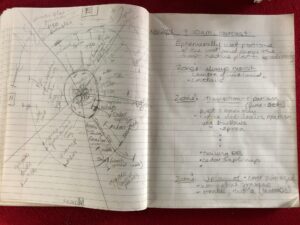Date: Nov 20, 2023
Time: 9-10am
Weather: Overcast, 4C
Observations/Data Collection:

The wetland was divided into 3 Zones based on hydrology/elevation. Zone 1 is always submerged in water. Zone 2 is submerged Fall-Spring. Zone 3 is never submerged.
The wetland was then divided into 5 wedges, each encompassing a portion of Zones 1-3. Vegetation was identified, as much as possible, in each zone of each wedge. Wedge C (facing East) gets the most sun exposure on this property, which likely explains the presence of higher numbers of invasive species in the upland Zone 3.
[Note: Photos of each Wedge will be submitted through moodle with Small Assignments]
Zone 1, the inner zone, lowest elevation (110m), is submerged with water all year:
-Native Vegetation: Broadleaf Cattail for all 5 wedges
-Invasive Vegetation: Reed Canary Grass for all 5 wedges
Zone 2, the middle or transition zone, mid-elevation (115m), is submerged mid/early Fall to late-Spring each year:
Wedge A (South-West):
-Native Vegetation: Red Alder, Spirea/Hardhack, Native Deciduous Riparian young trees/tall shrubs (Willow spp, Black Cottonwood), Western Red Cedar saplings, Trailing Blackberry, Wild Strawberry, Carex Spp, Western Buttercup, Mosses, Salal (in upper part into upland Zone 3).
-Invasive Vegetation: Himalayan Blackberry/Brambles
Wedge B (South-East):
-Native Vegetation: Red Alder, Spirea/Hardhack, Native Deciduous Riparian young trees/tall shrubs (Willow spp, Black Cottonwood), Trailing Blackberry, Wild Strawberry, Juncus spp, Carex Spp, Western Buttercup, Mosses, Salal (in upper part into upland Zone 3).
-Invasive Vegetation: Himalayan Blackberry/Brambles, Reed Canary Grass.
Wedge C (East):
-Native Vegetation: Red Alder, Spirea/Hardhack,Native Deciduous Riparian young trees/tall shrubs (Willow spp, Black Cottonwood), Trailing Blackberry, Wild Strawberry, Juncus spp, Carex Spp, Western Buttercup, Mosses, Salal (in upper part into upland Zone 3).
-Invasive Vegetation: Himalayan Blackberry/Brambles, Reed Canary Grass, Thistles
Wedge D (North):
-Native Vegetation: Red Alder, Spirea/Hardhack, Native Deciduous Riparian young trees/tall shrubs (Willow spp, Black Cottonwood), Trailing Blackberry, Wild Strawberry, Juncus spp, Carex Spp, Western Buttercup, Mosses, Salal (in upper part into upland Zone 3).
-Invasive Vegetation: Himalayan Blackberry/Brambles, Reed Canary Grass
Wedge E (North-West):
-Native Vegetation: Red Alder, Spirea/Hardhack, Native Deciduous Riparian young trees/tall shrubs (Willow spp, Black Cottonwood), Trailing Blackberry, Wild Strawberry, Juncus spp, Carex Spp, Western Buttercup, Mosses, Salal (in upper part into upland Zone 3).
-Invasive Vegetation: Himalayan Blackberry/Brambles, Reed Canary Grass
Zone 3, the outer or upland zone, highest elevation (120m), is rarely, if ever, submerged in water (perhaps only briefly during major precipitation events):
Wedge A (SW):
-Native Vegetation: Douglas fir (large tree), salal, Trailing Blackberry, Western Buttercup, Mosses.
-Invasive Vegetation: Himalayan Blackberry/Brambles, lawn/pasture grasses
Wedge B (SE):
-Native Vegetation: Trailing Blackberry, Western Buttercup, Mosses, Salal.
-Invasive Vegetation: Himalayan Blackberry/Brambles, lawn/pasture grasses, Thistles, Queen Anne’s Lace (1 plant), lawn/pasture grasses
Wedge C (E):
-Native Vegetation: Trailing Blackberry, Western Buttercup, Mosses, Salal.
-Invasive Vegetation: Himalayan Blackberry/Brambles, lawn/pasture grasses, Thistles, Queen Anne’s Lace (1 plant), lawn/pasture grasses
Wedge D (N):
-Native Vegetation: Trailing Blackberry, Western Buttercup, Mosses, Salal.
-Invasive Vegetation: Himalayan Blackberry/Brambles, lawn/pasture grasses, Thistles, Reed Canary Grass,
Wedge E (NW):
-Native Vegetation: Trailing Blackberry, Western Buttercup
-Invasive Vegetation: Himalayan Blackberry/Brambles, lawn/pasture grasses, Thistles
~~~
Prediction: Ephemerally submerged areas are best able to support native species diversity and richness in this wetland.
HYPOTHESIS: Ephemerally submerged areas are best able to support native species diversity and richness. Hydrology is the key predictor variable for the types of plant species likely to be present in each Zone of this wetland. Aspect/amount of sun exposure may be a distant secondary predictor variable, but likely only for the Upland (Zone 3).
~~~
The variables for this study are categorical because they are classified into unique categories:
-Predictor variable: type of hydrology (permanently wet, ephemerally wet, dry/upland)
-Response variables: plant species name and type of plant species (native or invasive).
The design of this study is a Logistical Regression observational study. It is primarily a One-Way Layout where three types of hydrological treatments are considered. However, aspect is also considered as a predictor variable for upland species.
okay interesting!
questions/comments:
– I think the explanatory or response variable should be rewritten as “number of” or native plant species diversity (index? count?) so it is something measurable
– if you are looking at native species, can you ignore the introduced (invasive)? or are you considering the proportion of native: invasive?
– hydrology as a key predictor — is it elevation, or amount of time covered, vs hydrology (which is literally the study of water movement, distribution, and management of water) – in essence, it is the zone, with the type of zone being the treatment area
– not sure of the sampling unit here – are you counting everything within a wedge? or doing a sample transect, &/or sample quadrats? remember the rule of 10 in Gotelli
this may be of interest: https://www.epa.gov/sites/default/files/2015-03/documents/ephemeral_streams_report_final_508-kepner.pdf